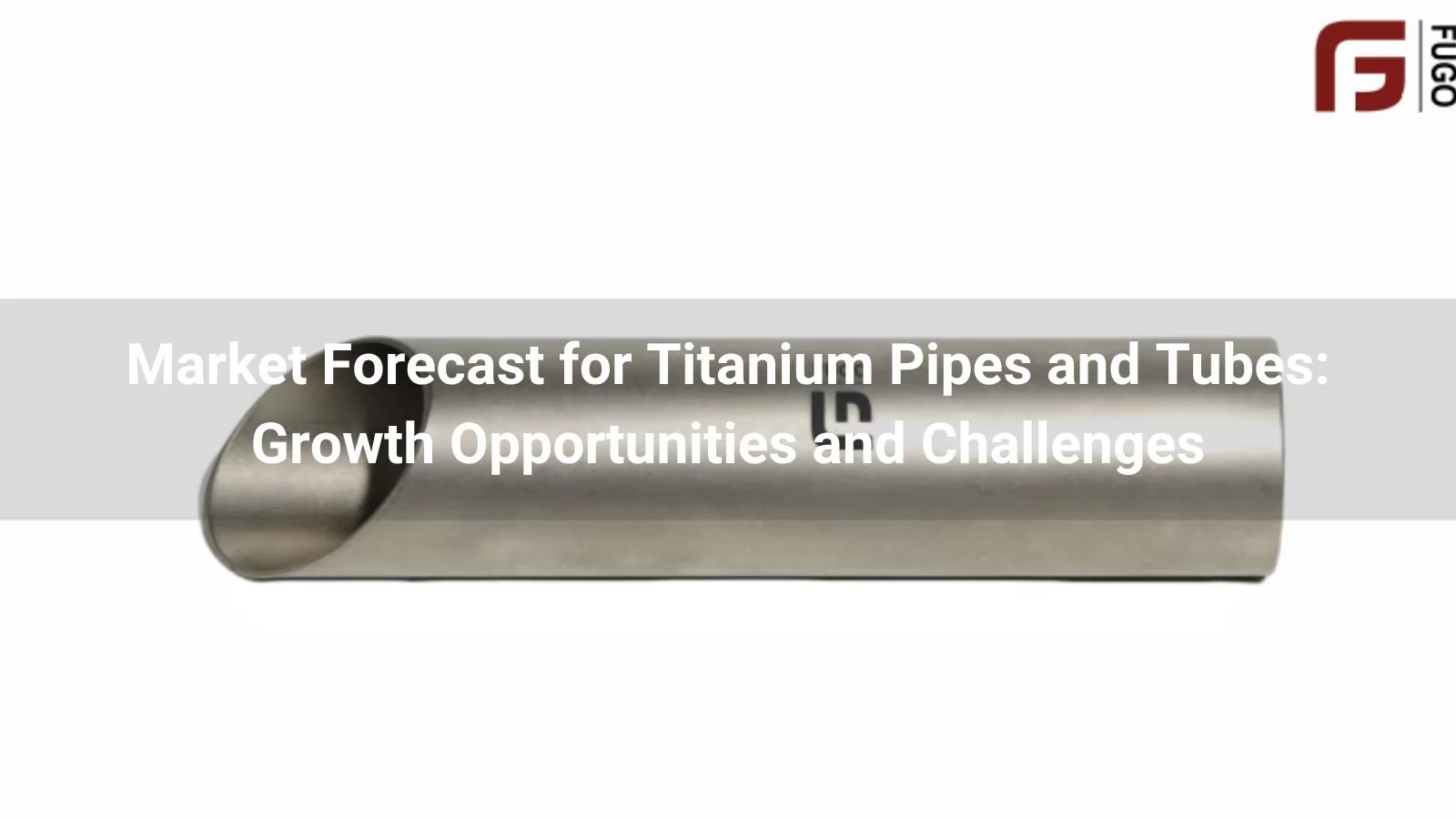


Titanium pipes and tubes, prized for their exceptional strength-to-weight ratio, corrosion resistance, and biocompatibility, are critical components in industries such as aerospace, chemical processing, oil and gas, medical, and marine engineering. As global demand for durable, lightweight, and sustainable materials grows, the titanium pipes and tubes market is poised for significant expansion. This article explores the market forecast for titanium pipes and tubes, highlighting growth opportunities, key challenges, and emerging trends through 2031, based on recent industry analyses.
The global titanium pipes and tubes market is experiencing robust growth. According to industry reports, the market was valued at approximately USD 2.2–2.3 billion in 2023 and is projected to reach USD 3.83–3.84 billion by 2031, growing at a compound annual growth rate (CAGR) of 5.6–7.19% during the forecast period (2025–2031). For seamless titanium tubes specifically, the market size was USD 0.38 billion in 2025 and is expected to reach USD 0.59 billion by 2032, with a CAGR of 5.6%. These projections reflect strong demand across multiple sectors and advancements in manufacturing technologies.
The market is segmented by product type (seamless and welded tubes), application (aerospace, medical, industrial, marine, oil and gas), and geography (North America, Europe, Asia-Pacific, South America, Middle East, and Africa). Seamless tubes dominate due to their uniform structure and suitability for high-pressure applications, while welded tubes are gaining traction in cost-sensitive markets.
Several factors are driving the growth of the titanium pipes and tubes market, creating lucrative opportunities for manufacturers, suppliers, and stakeholders.
The aerospace industry remains the largest consumer of titanium pipes and tubes, accounting for over 40% of market revenue in 2023. Titanium’s lightweight properties and resistance to extreme temperatures make it ideal for aircraft hydraulic systems, structural components, and spacecraft. The rise in global air travel, increasing aircraft production (especially in emerging economies), and growing space exploration missions are fueling demand. For instance, the development of next-generation fuel-efficient aircraft and satellite launches will continue to drive the need for titanium tubing.
Titanium’s biocompatibility and non-reactive nature make it a preferred material for medical implants, such as orthopedic devices, dental implants, and cardiovascular components. The aging global population and rising prevalence of chronic diseases are increasing demand for advanced medical devices. Innovations like ultra-small diameter titanium tubes and 3D-printed implants are creating new growth avenues. The medical sector is expected to remain a significant end-use market through 2031.
The oil and gas industry relies on titanium pipes and tubes for pipelines, subsea equipment, and pressure vessels in harsh environments with corrosive substances like hydrogen sulfide (H₂S) and carbon dioxide (CO₂). Rising global energy demands and investments in offshore drilling and cross-country pipelines are boosting market growth. Titanium’s long lifespan and corrosion resistance reduce maintenance costs, making it a cost-effective choice despite higher upfront costs.
Titanium’s ability to withstand high temperatures and corrosive conditions positions it as a key material in emerging sectors like renewable energy and desalination. Geothermal power plants, solar thermal systems, and desalination plants increasingly use titanium tubing for heat exchangers and pipelines. As governments prioritize sustainable infrastructure, these applications are expected to drive market expansion.
Innovations in manufacturing, such as precision machining, 3D printing, and advanced titanium alloy development, are enhancing production efficiency and reducing costs. Additive manufacturing enables customized, lightweight designs, minimizing waste and expanding applications in aerospace and medical sectors. Ongoing research into beta titanium alloys, which offer improved strength and formability, is opening new possibilities for automotive and industrial applications.
The Asia-Pacific region, led by China and India, is the largest and fastest-growing market, accounting for over 43% of global titanium market revenue in 2023. Rapid industrialization, infrastructure development, and the presence of major titanium producers drive this dominance. Increasing demand from aerospace, chemical processing, and automotive sectors, coupled with government investments in renewable energy, will sustain growth in this region.
Despite its promising outlook, the titanium pipes and tubes market faces several challenges that could hinder growth.
Titanium extraction and processing are energy-intensive and complex, involving multiple steps like the Kroll process, melting, extrusion, and finishing. These processes require specialized equipment and skilled labor, leading to high production costs. The elevated price of titanium tubing compared to alternatives like stainless steel or copper limits its adoption in cost-sensitive industries, particularly in developing countries.
The titanium supply chain is constrained by limited raw material sources and geopolitical factors. For example, disruptions caused by the Russia-Ukraine conflict in 2022 led to price volatility, as Russia is a major titanium exporter. Such uncertainties can cause production delays and higher costs, impacting market stability.
Titanium faces competition from materials like stainless steel, carbon steel, and composite alloys, which are often cheaper and easier to produce. In applications where cost is prioritized over performance, these alternatives may limit titanium’s market penetration. For instance, stainless steel pipes dominate in construction and plumbing due to their lower cost.
While titanium is durable, its recycling process is costly and less developed compared to metals like copper or steel. The lack of efficient recycling methods limits its sustainability appeal, especially as industries face increasing pressure to adopt eco-friendly practices. This challenge could restrict market growth in environmentally conscious markets.
Titanium mining and processing raise environmental concerns due to energy consumption and waste generation. Stringent regulations in regions like Europe and North America may increase compliance costs, affecting operational feasibility. Additionally, regulatory hurdles in aerospace and medical applications require rigorous testing and certification, potentially delaying market entry.
Several trends are shaping the titanium pipes and tubes market, offering insights into its future trajectory:
l Sustainability Focus: Increasing emphasis on eco-friendly production and recycling is pushing manufacturers to develop greener processes, such as using reclaimed titanium or energy-efficient extraction methods.
l Lightweight Materials Demand: The automotive industry’s shift toward electric vehicles (EVs) and high-performance vehicles is driving demand for lightweight titanium tubing to improve fuel efficiency and performance.
l Additive Manufacturing: 3D printing is revolutionizing titanium tube production, enabling complex designs and reducing material waste. This trend is particularly impactful in aerospace and medical applications.
l Strategic Partnerships: Companies are forming alliances to enhance technological capabilities and market reach. For example, in 2022, PTC Industries and Mishra Dhatu Nigam (MIDHANI) partnered to manufacture titanium alloy pipes using local raw materials, strengthening domestic supply chains.
l Regional Expansion: North America and Europe remain key markets due to advanced manufacturing facilities and strong aerospace and medical sectors, while Asia-Pacific is expected to see the highest growth rate due to industrial and infrastructure development.
The titanium pipes and tubes market is highly competitive, with key players including Titanium Industries, Allegheny Technologies (ATI), VSMPO-AVISMA, Baoji Titanium Industry Co., Ltd., Sandvik, and Haynes International. These companies are investing in R&D, expanding production capacity, and forming strategic partnerships to maintain market share. For instance, Perryman Company’s 2022 expansion of titanium melting capacity in Pennsylvania aims to meet growing aerospace and medical demand. Mergers, acquisitions, and new product launches are common strategies to strengthen market positions.
The titanium pipes and tubes market is set for steady growth through 2031, driven by demand from aerospace, medical, oil and gas, and emerging renewable energy sectors. Technological advancements, such as 3D printing and new alloy development, will enhance production efficiency and expand applications. However, high costs, supply chain vulnerabilities, and competition from alternative materials pose ongoing challenges.
To capitalize on growth opportunities, stakeholders should focus on:
l Cost Reduction: Investing in R&D to streamline extraction and manufacturing processes.
l Sustainability: Developing efficient recycling methods and eco-friendly production techniques.
l Market Diversification: Exploring new applications in renewable energy, desalination, and automotive sectors.
l Regional Strategies: Targeting high-growth markets like Asia-Pacific while maintaining strong presence in North America and Europe.
Titanium pipes and tubes are at the forefront of material innovation, offering unmatched performance in demanding environments. With a projected market value of USD 3.83–3.84 billion by 2031, the industry presents significant opportunities for growth, particularly in aerospace, medical, and renewable energy applications. However, addressing challenges like high production costs and supply chain constraints will be critical to sustaining this growth. As industries prioritize durability, lightweight design, and sustainability, titanium pipes and tubes will continue to play a pivotal role in shaping the future of advanced manufacturing and infrastructure.
If you are looking for a reliable Chinese supplier, Contact us at Fugo Tech now!



Fugo Tech is focused on the manufacturing of clad metal plate and distributes the Stainless Steel, Titanium, Nickel Alloy, Zirconium and other non-ferrous metal pipes, fittings, flanges, and fasteners.